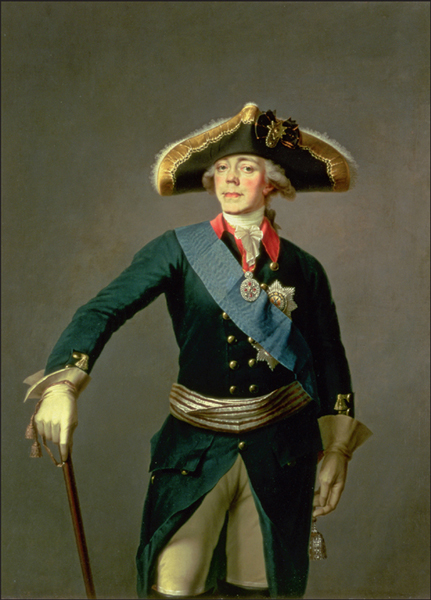
The imperial coronation crown designed for Catherine. The crown was used in all six of the Romanov coronations that followed.
(RIA Novosti)

Prince Christian Augustus of Anhalt-Zerbst, father of Princess Sophia, who would become Catherine the Great

Princess Johanna Elizabeth of Holstein-Gottorp, Sophia’s mother

Empress Elizabeth, daughter of Peter the Great, who brought Sophia to Russia at fourteen and changed her name to Catherine. The empress then married the adolescent girl to her nephew, Peter, and charged her with immediately producing an infant to secure the dynasty.
(Photograph © The State Hermitage Museum; photo by Vladimir Terebenin, Leonard Kheifets, Yuri Molodkovets)

Catherine at sixteen, at the Russian court
(Portrait of Grand Duchess Ekatrina Alekseyevna, later Catherine II, c. 1745 by Georg Christoph Grooth (1716–49), Hermitage, St. Petersburg, Russia/The Bridgeman Art Library)

Catherine and her new husband, who would become Emperor Peter III
(Portrait of Catherine the Great (1729–96) and Prince Petr Fedorovich (1728–62), 1740–45 (oil on canvas) by Georg Christoph Grooth (1716–49), © Odessa Fine Arts Museum, Ukraine/The Bridgeman Art Library)

Portrait of Peter III

Stanislaus Poniatowski, Catherine’s second lover and later king of Poland, an office forced on him by Catherine
(Stanislaus II Augustus, King of Poland, c. 1790? by Marcello Bacciarelli, oil on canvas, © by permission of the Trustees of Dulwich Picture Gallery)

Sergei Saltykov, Catherine’s first lover and the possible father of her son Paul. Catherine described Saltykov in her memoirs as “handsome as the dawn,” an opinion not wholly confirmed by this portait.

Gregory Potemkin, covered with medals, titles, land, palaces, and responsibilities by a passionately loving Catherine
(Photograph © The State Hermitage Museum; photo by Vladimir Terebenin, Leonard Kheifets, Yuri Molodkovets)

Gregory Orlov, Catherine’s third lover, who was with her for eleven years and helped to put her on the throne

Catherine preparing to march on Peterhof, where she would force Peter III to abdicate
(Equestrian Portrait of Catherine II (1729–96) the Great of Russia (oil on canvas) by Vigilius Erichsen (1722–82), Musée des Beaux-Arts, Chartres, France/The Bridgeman Art Library)

Catherine’s coronation portrait. She is wearing her new imperial crown.
(RIA Novosti)

Paul, Catherine’s son, in one of the Prussian uniforms he delighted in wearing
(Portrait of Paul I, 1796–97 by Stepan Semenovich)

Voltaire at Ferney, during the years near the end of his life when he poured letters and praise on Catherine

Emelyan Pugachev, the false Peter III

The older Gregory Potemkin, the most important man in Catherine’s life
(Portrait of Prince Grigory Aleksandrovich Potemkin (1739–91), c. 1790 by Johann Baptist I Lampi (1751–1830), Hermitage, St. Petersburg, Russia/The Bridgeman Art Library)

Emperor Paul I

An aging Catherine with one of her greyhounds in the park at Tsarskoe Selo
(Walking in the Park at Tsarskoye Selo (with the Chessmen Column in the Background), 1794 (oil on canvas) by Vladimir Lukich Borovikovsky (1757–1825), Tretyakov Gallery, Moscow, Russia/The Bridgeman Art Library)

The Falconet statue of Peter the Great, created at Catherine’s command to emphasize her connection with the great reforming tsar.
The inscription on the pedestal, in Russian on one side and Latin on the other, reads, TO PETER THE FIRST, FROM CATHERINE THE SECOND.
(Equestrian statue of Peter I (1672–1725) the Great, 1782, by Etienne-Maurice Falconet (1716–91), St. Petersburg, Russia; Photo Giraudon/The Bridgeman Art Library)
 ТЕЛЕГРАМ
ТЕЛЕГРАМ Книжный Вестник
Книжный Вестник Поиск книг
Поиск книг Любовные романы
Любовные романы Саморазвитие
Саморазвитие Детективы
Детективы Фантастика
Фантастика Классика
Классика ВКОНТАКТЕ
ВКОНТАКТЕ